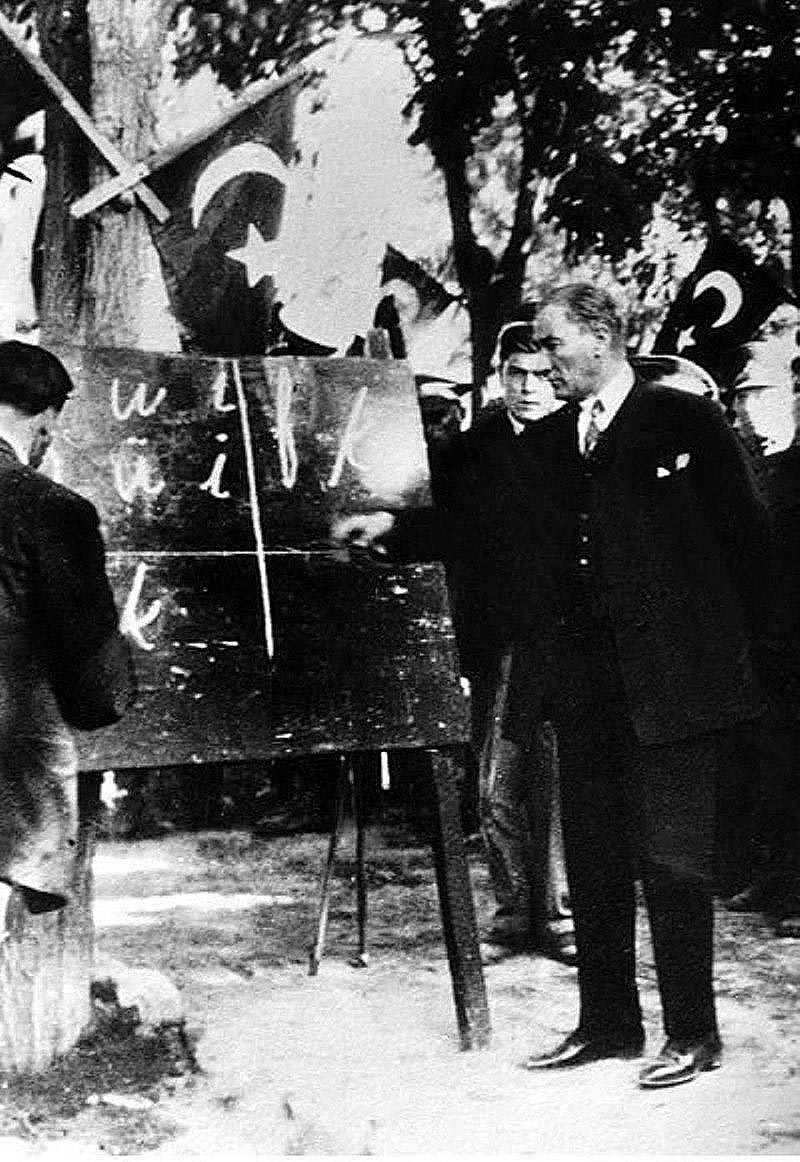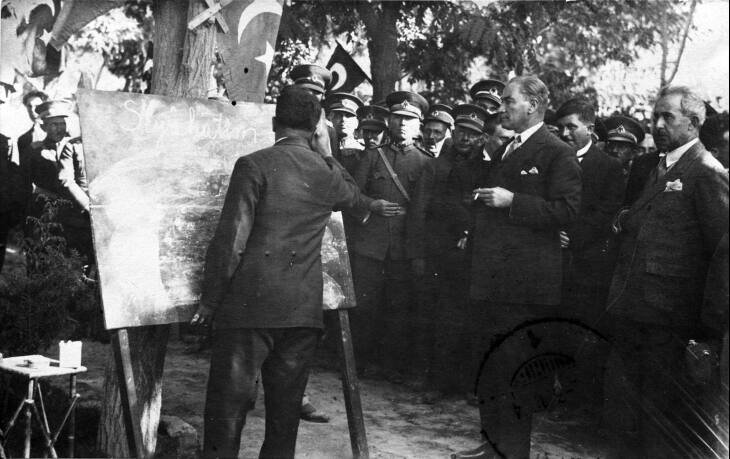Nation's Schools on:
[Wikipedia]
[Google]
[Amazon]
Nation’s school ( tr, Millet mektebi) was the name of a campaign of series of courses offered to adults to learn the

 The first example of the Nation’s school was set in Dolmabahçe Palace. Beginning by 1 January 1929, many schools were opened all over the country. Mustafa Necati, who was responsible for these schools, died on the very same day the schools opened due to appendicitis. He is now considered as one of the pioneers of the Turkish alphabet.
The first example of the Nation’s school was set in Dolmabahçe Palace. Beginning by 1 January 1929, many schools were opened all over the country. Mustafa Necati, who was responsible for these schools, died on the very same day the schools opened due to appendicitis. He is now considered as one of the pioneers of the Turkish alphabet.
/ref> Atatürk, who earned the title ''başöğretmen'' (literally "head teacher") actively participated in the Nation’s school program, and taught the new alphabet at his travels.
/ref> At the end of the term in the 1930s, the total number of the graduates reached 1,217,144.
Latin alphabet
The Latin alphabet or Roman alphabet is the collection of letters originally used by the ancient Romans to write the Latin language. Largely unaltered with the exception of extensions (such as diacritics), it used to write English and the o ...
in Turkey in 1929–1932.
Background
TheOttoman Empire
The Ottoman Empire, * ; is an archaic version. The definite article forms and were synonymous * and el, Оθωμανική Αυτοκρατορία, Othōmanikē Avtokratoria, label=none * info page on book at Martin Luther University) ...
, like many Islamic countries, used the Arabic alphabet, even though it was not able to reproduce certain Turkish vowels. Because the alphabet stemmed from the Quran
The Quran (, ; Standard Arabic: , Classical Arabic, Quranic Arabic: , , 'the recitation'), also romanized Qur'an or Koran, is the central religious text of Islam, believed by Muslims to be a revelation in Islam, revelation from God in Islam, ...
, it was considered unalterable. After the collapse of the Empire, the leader of the Turkish Republic
Turkey ( tr, Türkiye ), officially the Republic of Türkiye ( tr, Türkiye Cumhuriyeti, links=no ), is a transcontinental country located mainly on the Anatolian Peninsula in Western Asia, with a small portion on the Balkan Peninsula in ...
, Mustafa Kemal Atatürk
Mustafa Kemal Atatürk, or Mustafa Kemal Pasha until 1921, and Ghazi Mustafa Kemal from 1921 Surname Law (Turkey), until 1934 ( 1881 – 10 November 1938) was a Turkish Mareşal (Turkey), field marshal, Turkish National Movement, re ...
, adopted the Latin alphabet
The Latin alphabet or Roman alphabet is the collection of letters originally used by the ancient Romans to write the Latin language. Largely unaltered with the exception of extensions (such as diacritics), it used to write English and the o ...
in 1928, adjusting it to suit the Turkish language: omitting "Q", "W" and "X", and adding diacritical
A diacritic (also diacritical mark, diacritical point, diacritical sign, or accent) is a glyph added to a letter or to a basic glyph. The term derives from the Ancient Greek (, "distinguishing"), from (, "to distinguish"). The word ''diacriti ...
marks to create umlaut versions of "O", "U" and "I", and the accented letters "Ç", "Ş" and "Ğ".
In English such accented letters are usually written ''Ch'', ''Sh'' and ''Gh''
Alphabet reform
In June 1928, Atatürk askedMustafa Necati
Mustafa Necati, also known as Mustafa Necati Uğural (1894 - January 1, 1929) was a Turkish statesman in the early years of the Turkish Republic, who served as the Minister of National Education during the reform period. He died before the Turk ...
, the Minister of National Education
Moral and national education (MNE), initially known as Moral and civic education (MCE), was a school curriculum proposed by the Education Bureau of Hong Kong in 2012.
The subject was controversial for its stance on the Chinese Communist Part ...
to form a committee to adopt the Latin alphabet. On 9 August 1928, Atatürk announced that the Latin alphabet would replace the Arabic alphabet. On 1 November 1928, the parliament
In modern politics, and history, a parliament is a legislative body of government. Generally, a modern parliament has three functions: Representation (politics), representing the Election#Suffrage, electorate, making laws, and overseeing ...
passed the law of the new Turkish alphabet as Act no 1353, and on 11 November 1928, the government
A government is the system or group of people governing an organized community, generally a state.
In the case of its broad associative definition, government normally consists of legislature, executive, and judiciary. Government is a ...
decided to establish the "nation’s school". The project started on 24 November 1928. These schools were actually series of short courses for the adults. According to Falih Rıfkı Atay
Falih Rıfkı Atay (1894– 20 March 1971) was a Turkish journalist, writer and politician between 1923 and 1950.
Biography
Falih Rıfkı was the son of Halil Hilmi Efendi, an imam. He was educated in Istanbul, Ottoman Empire. Falih began his ...
, a member of the committee, learning of the Latin alphabet was more difficult for the literate people, who already used Arabic alphabet than for the illiterate people. He added that if the rate of literacy was not so low, the alphabet reform would be impossible.
First day of the campaign

 The first example of the Nation’s school was set in Dolmabahçe Palace. Beginning by 1 January 1929, many schools were opened all over the country. Mustafa Necati, who was responsible for these schools, died on the very same day the schools opened due to appendicitis. He is now considered as one of the pioneers of the Turkish alphabet.
The first example of the Nation’s school was set in Dolmabahçe Palace. Beginning by 1 January 1929, many schools were opened all over the country. Mustafa Necati, who was responsible for these schools, died on the very same day the schools opened due to appendicitis. He is now considered as one of the pioneers of the Turkish alphabet.
School regulations
According to regulations, these schools were compulsory for everybody in the age group of 14–45 years. Two courses per week were offered to women while four courses a week were available for men. The duration was 2–4 months depending on the prior education of the participants. The courses were also offered to prisoners. In the 1930s, most villages had no schools. For these villages mobile teaching teams were formed. All participants were expected to pass a final exam to obtain a certificate. The top scoring participant of each school received a signed photo of Atatürk and a book of the Turkish constitution.Serenti page/ref> Atatürk, who earned the title ''başöğretmen'' (literally "head teacher") actively participated in the Nation’s school program, and taught the new alphabet at his travels.
Conclusion
In the first year, the number of schools, actually classrooms, was 20,487, and the number of participants was 1,075,500. 485,632 men and 111,378 women received certificates./ref> At the end of the term in the 1930s, the total number of the graduates reached 1,217,144.
Commemoration
Beginning by 1981, 24 November, being the start day of the project, is commemorated each year as "Teacher's day" in Turkey.See also
* Education in TurkeyFootnotes
{{Reflist, group=NoteReferences